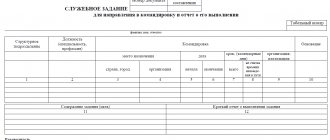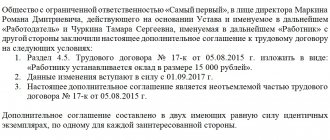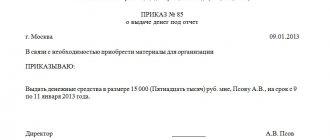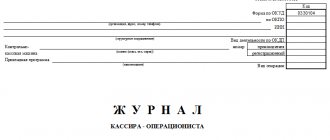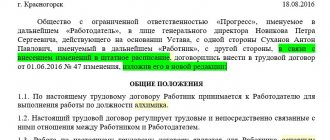What is a reprimand and what does it mean for an employee?
A reprimand is one of the most common types of disciplinary action (read the order on disciplinary action) and is the mildest punishment. Typically, the employer resorts to precisely this measure of influence when he wants to warn the employee about the inadmissibility of such violations in the future.
The remark does not have to be included in the employee’s personal file, but sometimes employers do so. In addition, the remark may be accompanied by such an action as the cancellation of bonus payments (if this type of incentive is provided for in the employee’s employment contract).
Procedure for applying disciplinary action
Let us remind you that the main responsibilities of an employee include, in particular (Part 2 of Article 21 of the Labor Code of the Russian Federation):
- conscientious performance of labor duties assigned to the employee by the employment contract;
- compliance with internal labor regulations;
- compliance with labor discipline;
- compliance with established labor standards;
- compliance with occupational health and safety requirements;
- careful attitude towards the property of the employer and other employees.
Accordingly, failure to fulfill obligations under an employment contract, failure to comply with internal labor regulations, job descriptions, regulations, orders of the employer constitute disciplinary offenses for which the employee may face disciplinary liability.
Examples of such violations are the absence of an employee without good reason from the workplace, the refusal of an employee to perform labor duties without good reason in connection with a change in labor standards in the established order, refusal or evasion without good reason from a mandatory medical examination (clause 35 of the Resolution of the Plenum of the Supreme Court dated 03/17/2004 No. 2).
Disciplinary sanctions in order of increasing severity are (Part 1 of Article 192 of the Labor Code of the Russian Federation):
But the application of penalties in this order is not at all necessary. After all, the severity of a disciplinary sanction depends on the severity of the offense committed and the circumstances under which it was committed (Part.
5 tbsp. 192 of the Labor Code of the Russian Federation).
However, it must be taken into account that for each disciplinary offense only one disciplinary sanction can be applied (Part 5 of Art.
193 Labor Code of the Russian Federation).
How long does a remark last?
After an employer has reprimanded his subordinate, the latter must keep in mind that for a year after that he will be under close supervision.
If during this period there are no repeated violations, then the remark will be automatically canceled and all the employee’s rights will be restored in full, but if something similar happens again, the offender may be punished more severely: with a reprimand or even dismissal.
It should be noted that the employer has the right to early cancel a disciplinary sanction previously applied to an employee. This is quite simple to do: you just need to issue the appropriate order to cancel the order and familiarize the responsible persons with it, as well as the employee himself. Typically, the reason for canceling a penalty is repentance, clear signs of correction by the employee, strict adherence to labor discipline and excellent work performance.
Order on disciplinary liability: procedure for issuance
If an employee violates labor discipline, the employer has the right to draw up an order to apply disciplinary liability to him, for which 1 month is given from the moment the offense was discovered (Part 6 of Article 193 of the Labor Code of the Russian Federation), but within a 6-month period from the date of its commission.
IMPORTANT! Exceptions are violations identified during an audit or inspection (they can be punished within 2 years after they were committed), as well as those established in a criminal case (there is no limit period).
When imposing a penalty, the severity of the violation and the circumstances of its commission must be examined (Part 5 of Article 192 of the Labor Code of the Russian Federation).
Before drawing up an order to impose disciplinary liability, the employer must:
- Record the violation in an act or other document.
- Request an explanation from the employee, for which the latter is given 2 working days to compile.
- If necessary, after the expiration of the specified period, draw up an act of refusal to provide explanations.
- Consult with the trade union in accordance with Art. 373 of the Labor Code of the Russian Federation, if the violator is its member, and the chosen penalty is dismissal.
- Issue a collection order.
The procedure for issuing an order is as follows (Part 6 of Article 193 of the Labor Code of the Russian Federation):
- Registration of the order itself.
- Familiarization with it by the employee within 3 days (only days spent at work are counted) and provision of a copy upon the employee’s request.
- Drawing up the appropriate inscription on the order if the employee refuses to sign (Part 2 of Article 84.1 of the Labor Code of the Russian Federation).
Read about what types of disciplinary liability can be applied by an employer to an employee in the ready-made solution of ConsultantPlus. If you do not yet have access to the ConsultantPlus system, you can obtain it free of charge for 2 days.
Basis for the order
Absolutely any order drawn up on behalf of the company’s management must have a written basis. In most cases, this is
- a memorandum or memo from the head of the structural unit in which the offending employee works,
- as well as an act recording the offense and an explanatory note.
Without these papers, the document will not be considered justified and in which case it will be very easy to refute it; moreover, for the lack of a basis for writing the order, and therefore the penalty itself, the employer may be subject to administrative punishment.
Is it possible to appeal
The boss, at his discretion, may subject the employee to disciplinary action.
For his own protection, a person can write an explanatory note indicating the following information:
Free legal consultation
We will answer your question in 5 minutes!
Free legal consultation We will answer your question in 5 minutes!
Call: 8 800 511-39-66
Ask a Question
- about the facts relating to the offense;
- about all the reasons that led to the disciplinary violation. For example, if a person was punished due to absenteeism, then he can provide information and documents confirming the presence of a good reason.
This is also important to know:
How to write a statement to the prosecutor’s office: examples and samples
At the end of the document, it is required to indicate an admission of one’s own guilt or the fact that actions on the part of the boss were unreasonable.
If, despite the explanatory note, the manager issues an order, the employee may appeal to:
- court;
- labor inspection;
- labor dispute commission.
It is worth considering that an application can be submitted to three authorities at once. The most common way to challenge is to go to court.
To do this, a person must file a claim. To make a decision in favor of the employee, the citizen must provide evidence that the reprimand was imposed unlawfully.
Procedure for announcing a comment
Before reprimanding an employee, the employer is required by law to first record the violation itself (for this purpose, a special act details the essence of what happened, the date and time of the event), and then receive an explanation from the employee regarding the fact of the violation.
Explanations must be given in no more than two working days - if they are not there, it is considered that the employee does not have valid reasons to justify the offense committed.
If there are explanations, but the employer did not consider them weighty enough (and this opinion is confirmed by the law), this also serves as a basis for disciplinary action.
Next, an order is drawn up, which assigns a penalty in the form of a reprimand.
If the offender does not want to sign the document, a corresponding act should be drawn up about this.
The employee in respect of whom the order was issued must be familiarized with it within three days against signature, as well as those employees of the enterprise who are responsible for the implementation of this order.
The procedure for imposing a disciplinary sanction should be treated very carefully, because if the matter comes to proceedings in the labor inspectorate or court, the entire process and every piece of paper in it will be examined “under a microscope.”
Order to impose a disciplinary sanction: samples
To know how to correctly implement the use of liability measures against an employee for a disciplinary offense, read the orders on the application of disciplinary sanctions, samples of which are located below.
DV in the form of a warning: sample order
For failure to fulfill or incorrect fulfillment of obligations, a worker may be given a warning in the form of a reprimand or reprimand before being dismissed from his position.
Order on DV in the form of a comment
Among these measures, a reprimand for a disciplinary sanction is recognized as the mildest sanction on the part of management. For clarity, view a sample order of disciplinary action for absenteeism.
Order on DV in the form of a reprimand
Such measures of responsibility motivate workers to violate labor discipline less. Next, we present a sample order for disciplinary action in the form of a reprimand.
Rules for drawing up an order
Today there is no unified sample order for disciplinary action, so employers can write it in any form or according to a template developed within the enterprise. In this case, it is necessary that this document contain a number of certain information, including:
- name of company,
- Document Number,
- the date and place of its preparation,
- personal data about the offending employee (his position and full name).
The order must indicate the reason for its creation (i.e., indicate the essence of the complaint against the employee), the date of the offense, and also provide references to the basis. The latter are usually an act recording the violation and a report or official note from the head of the offender and an explanatory note (if any).
Example of a reprimand order
When the HR department collects the entire evidence base and creates a folder with reports, acts and explanatory notes, then you can proceed to issuing an order to impose a penalty in the form of a reprimand. It can be issued in any form. Here is a sample order that was drawn up in 2020:
full name of the organization
ORDER No. 45-k on disciplinary action in the city of Tver 01/10/2020
Due to the fact that on January 9, 2020, worker V.V. Zhirinovsky was absent from the workplace without good reason for three hours, from 9:00 to 12:00, and on the basis of Article 192 of the Labor Code of the Russian Federation
1. For violation of labor discipline, reprimand V.V. Zhirinovsky. 2. Responsible for personnel records A.S. Lobkova to familiarize V.V. with this order. Zhirinovskaya signed.
Reasons: memo of the senior manager dated 01/09/2020 No. 56, explanatory note by V.V. Zhirinovskaya dated 01/09/2020 No. 12.
Director ____________ A.V. Petrov
The order has been reviewed by: Worker ____________ V. Zhirinovsky 01/11/2020
Author: Andrey Tkach, head of the HR department of Metall-ASP LLC
An order to impose a disciplinary sanction is an administrative act by which an employee is punished for a violation. It is allowed to issue it not only within a month from the moment of the offense, in some cases the period is three years.
Rules for placing an order
The order can be drawn up in different versions: both in handwritten format and in printed form, both on a simple A4 sheet and on the company’s letterhead. However, he must have the original autograph of the director of the company or a person authorized to sign such papers. It is not necessary to endorse it using a seal, since it relates to the internal administrative documentation of the company; moreover, since 2016, legal entities are exempt from the need to certify their documentation using seals and stamps.
How to register correctly
The order is prepared in one copy and, after its publication, is stored together with other personnel documentation.
There is no unified mandatory sample order for imposing a disciplinary sanction. The employer has the right to independently develop a template for this document , which will then be used at the enterprise, or write it each time in a custom format.
The order is issued on the organization’s letterhead or regular A4 sheet, but in the latter case, you need to write down all the details of the employing company here.
The order must be certified by the director or any other authorized person to sign these documents in the company (regardless of who actually drew it up).
It is also possible to put the seal of the head on the order, but since 2016, the presence of seals for legal entities is optional.
The order must be accompanied by documents on the basis of which the employee was subject to penalties.
The order must be issued within a month after discovery of the fact that the employee has committed an offense. Typically, this period begins to count from the day the memorandum is issued. If the specified monthly period has been missed, then it cannot be restored, and the employer loses the right to bring the employee to recovery.
It is not allowed to hold an employee accountable if more than 6 months have passed since the date of the offense.
After the order is issued, the employee must be familiarized with it and signed within three days. If he refuses to put his signature, a note about this is made in the order in the presence of witnesses (under Part 6 of Article 193 of the Labor Code of the Russian Federation).
The Constitutional Court in its clarifications indicated that the specified legal norms on the mandatory familiarization of the employee with the order of punishment allow the employee to learn in a timely manner about the imposition of disciplinary liability and to appeal the order if he does not agree with it.
The Labor Inspectorate also recommends making notes about employees' familiarization with these orders in a special journal, as well as recording here acts of refusal to familiarize themselves.
A sample order for disciplinary action against an employee can be downloaded here.
After the order acquires legal force, the penalty against the employee will be valid for a year. If during this period the employer decides to terminate it early, then he should issue another administrative document canceling the penalty. This will also be required if the labor inspectorate or court considers the punishment of the employee illegal.
